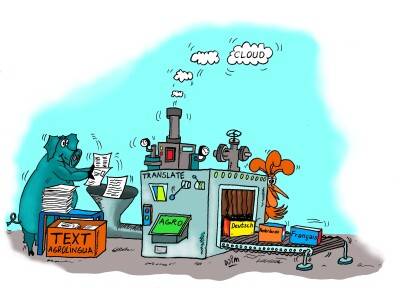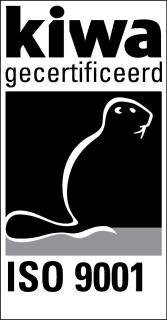
Computer assisted translation: useful tools for the translation process
Paper dictionaries used to be the only tool available to professional translators, but thanks to advances in technology, those days belong to the past. Nowadays, they can rely on advanced tools to make the translation process a little easier, and above all, more reliable. What are translation programs, translation memories and machine translations? And which types of texts are suitable for machine (pre)translation, and which aren’t? In this chapter, we’ll tell you more and explain what computer assisted translation entails.
Machine translations: increasingly reliable
Online translation engines like Google Translate and DeepL have seen rapid improvement in recent years. Not only are word databases increasing in size, but artificial intelligence is also getting smarter. Today's translation engines can recognise the context of words far better than in the early years of the computer, which means they're pretty much able to correctly translate complete sentences.
This means that using a translation agency is no longer required for every translation. If you receive an email which is written in Chinese, and which only requires understanding the general message, then an online translation engine will be sufficient. It’s even possible to translate a website with a single click of the mouse. This can be done if you use Chrome for example. You’ll gain a general understanding of a company’s products and services, and you’ll be able to understand product descriptions.
In short, if you want a rough idea of what a text is about, the increasingly advanced online translation engines are a real asset. It doesn’t matter if a sentence is grammatically incorrect or doesn’t flow. You get the gist of what’s written, which is all you need to know.
CAT Tools: advanced word processors for translators
It’s a different story if you’re not only translating texts for yourself, but for a target audience or the general public. In this case, we’d advise contacting a professional translation agency. After all, these types of translations must read like the original text, be grammatically flawless and consistent in their use of terminology.
Language professionals use tools that not only make the translation process more efficient, but also improve the quality. These are known as CAT tools. CAT standing for Computer Assisted Translation.
A common misunderstanding is that this translation software translate texts automatically, much like the online translation engines mentioned above. Yet this couldn’t be any further from the truth. CAT tools like Trados, MemoQ and Déjà Vu are actually word processors, in which the translator carries out the work. The translator is assisted by several tools that primarily monitor consistency. The most important being translation memories and term databases.
A translation memory is an integrated file containing all previous translations for a particular project or client. If the translator encounters a sentence that has been translated before, or bears a strong similarity to a previously translated sentence, they can directly insert the as yet unchanged sentence.
A term database works more or less in the same way. This is a list of fixed terms, used by a company for internal and external communication. These terms are usually sent to the translation agency by the client, after which the translator or project manager integrates the list into the CAT tool and subsequently updates and manages the term base.
Post editing: for efficient standard translations
In some cases, the combination of an extensive translation memory and a term database is sufficient for a reasonable translation. The translator only has to check and correct the text for mistakes, and make any necessary alterations.
Take a company that manufactures machines or other technical equipment for example. All of these products have instruction manuals containing similarly structured content. Translators don't have to rewrite the manual each time, but re-use sentences from the translation memory instead. Any minor changes, such as a different product name or model number, are marked by the CAT tool. This allows the translator to see instantly where the translation needs to be altered.
The benefits to the client are twofold: uniformity in communication is guaranteed and thanks to the significant time saving, the translation project is more cost effective.
The future: creative translation requires human input
We’re witnessing an increased sophistication in the capabilities of translation engines and CAT tools, which may reduce the opportunities for professional translators. Not only do they correctly predict and translate individual words, but they’re increasingly capable of correctly recognising and translating the context and sentence structure too.
This is especially good news for clients of translation agencies like AgroLingua, as the larger volumes of text can often be translated at a reduced price. When it comes to technical instructions and standardised texts, such as terms and conditions and other legal documents, this can be particularly advantageous.
But the input and skill of humans will remain indispensable, if only because CAT tools must be filled with the correct translation memories and term databases, and the expertise of the language professional is vital when checking the resulting text.
Creative translations can only ever be successfully performed by a human translator. The artificial intelligence behind machine translation might be getting smarter, but it still lacks the human characteristics that elevate the quality of a text: creativity and humour.
Wordplay is hardly ever recognised by translation engines, resulting in literal and often embarrassing translations. Language localisation* in translation is also beyond the capabilities of a computer. For these types of projects, a native speaker is essential. They are aware of current language usage, and know the culture, customs and values of the country in question.
That’s why AgroLingua always use native speakers, and see CAT tools and other language software as supporting tools in the translation process. Nothing more, nothing less.
* Localisation is the process of adapting a text to suit a different market. This ranges from adjusting currency and date formats, to rewriting complete texts. A task that can only be understood by residents of the country of origin. For example, think of descriptions referring to local current affairs or public figures, unknown elsewhere.
Want to learn more about our methods and the way we implement tools in our translation process? Then get in touch with the translation and localisation specialists at AgroLingua!
Back to blogs





